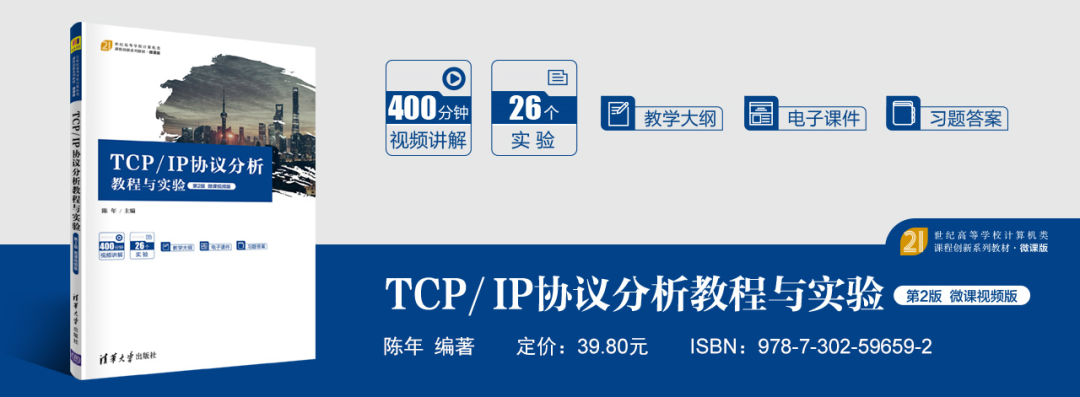
✦
Course Teaching Outline
✦
1
Basic Course Information
|
Course Chinese Name |
TCP/IP Protocol Analysis |
||
|
Course English Name |
TCP/IP Protocol Analysis |
||
|
Course Category |
Compulsory |
||
|
Applicable Majors |
Network Engineering, Internet of Things Engineering, Computer Science and Related Majors |
||
|
Total Class Hours |
32 |
Total Credits |
2 |
|
Prerequisite Courses |
Computer Networks |
||
|
Co-requisite Courses |
None |
||
|
Subsequent Courses |
Network Security, Network Programming Courses |
||
|
Course Introduction |
This course is a foundational technical course for the Network Engineering major. The course content covers the basic theory of the TCP/IP protocol suite, principles and working processes of commonly used application protocols. The course adopts a combination of lectures and practical exercises, focusing on in-depth analysis of protocol working processes through capturing protocol packets in network simulation and real environments, cultivating students’ practical and systematic understanding of networks, enhancing their ability to analyze and solve practical problems, and gradually enabling them to analyze and solve problems based on the kernel mechanisms of various layers of network protocols using effective engineering methods or techniques, while laying a necessary foundation of knowledge and technical methods for further study or research in computer networks. |
||
|
Recommended Textbook |
Chen Nian. TCP/IP Protocol Analysis Tutorial and Experiment (2nd Edition) Micro-course Video Version. Beijing: Tsinghua University Press, 2022. |
||
|
Textbook Supporting Resources |
400 minutes of experimental demonstration videos, 26 experimental projects, teaching outline, electronic courseware, exercise answers |
||
|
Reference Materials |
1. W. Richard Stevens. TCP/IP Illustrated Volume 1: Protocols [M]. Fan Jianhua et al. Translated. Beijing: Mechanical Industry Press, 2013. 2. Laura A. Chappell, Ed Tittle. TCP/IP Protocol Principles and Applications (3rd Edition) [M]. Beijing: Tsinghua University Press, 2009. 3. Lei Zhenjia. Computer Network Management (2nd Edition) [M]. Xi’an: Xi’an University of Electronic Science and Technology Press, 2012. 4. Xie Xiren. Computer Networks (7th Edition) [M]. Beijing: Electronic Industry Press, 2017. |
2
Course Objectives
To deeply and accurately grasp the working principles of the main protocols in the TCP/IP protocol suite, providing support for further application and study of network technology; to initially master 1-2 common network simulation and protocol analysis tools (Cisco PacketTracer, Wireshark) to prepare for theoretical research and engineering practice.
2.1 Knowledge Objectives
Master the concepts, working principles, and operating mechanisms of the main protocols in the TCP/IP protocol suite, including the following main content:
-
Master the Ethernet and IEEE 802 packet structure;
-
Master the composition of ARP packets and the address resolution process;
-
Master the message structure and working process of ICMP error and control messages, the principle of the Ping program;
-
Master the principles of IP routing, the principle of the traceroute program;
-
Master the message structure and working principles of UDP and TCP;
-
Understand IGMP, DNS, BOOTP protocols;
-
Understand the domain name system, file transfer protocol, email transfer protocol, remote login protocol, hypertext transfer protocol.
2.2 Skill Objectives
(1) Basic mastery of using PT simulation to build network experiments and view packet or message content;
(2) Basic mastery of capturing packets and viewing packets using Wireshark;
(3) Understand the usage of GNS3.
2.3 Quality Ability Objectives
(1) By analyzing and reproducing the working process of protocols, deepen the understanding of protocol design and working principles, cultivate a certain degree of network engineering practice and research ability;
(2) By constructing network application topologies and analyzing the working process of protocols, cultivate the ability to capture protocol data, analyze data, and solve network engineering problems according to different network conditions;
(3) By independently designing network topologies and working conditions, analyze and explore network phenomena and protocol working principles, stimulate self-learning enthusiasm, and cultivate self-learning ability;
(4) By learning to use various simulation software or packet capture tools, cultivate the ability to learn and use software tools.
3
Course Objectives and Graduation Requirements Correspondence
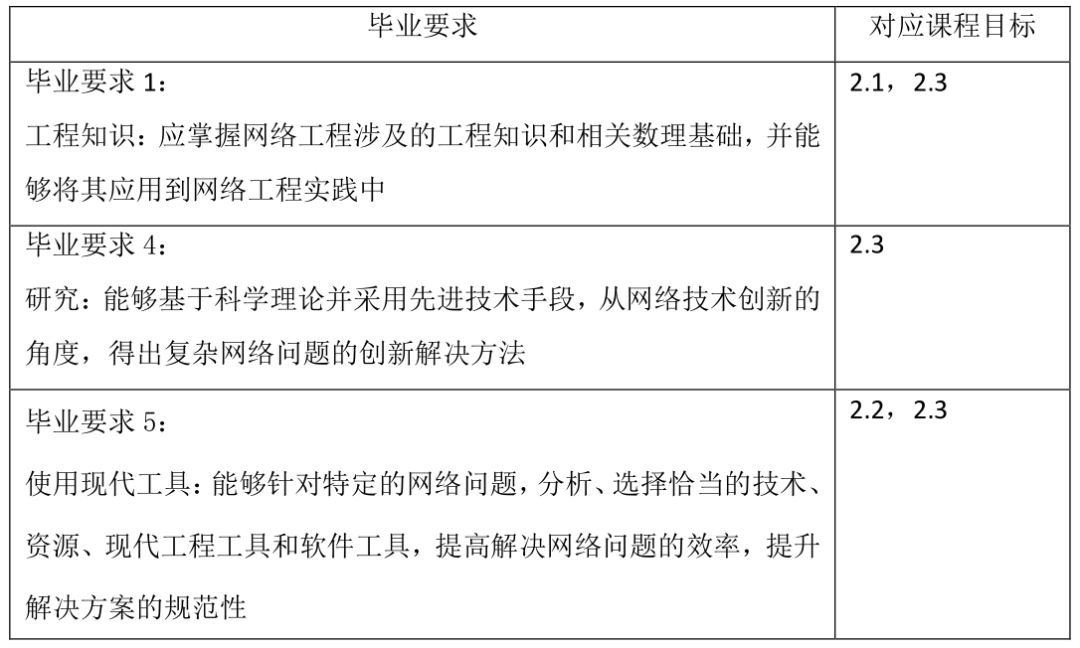
4
Basic Teaching Requirements and Content
To achieve the course objectives, a combination of lectures and practical exercises will be used.
The course schedule will focus on each teaching theme, where the teacher explains the basic principles and technical methods while demonstrating relevant experimental operations; then, students will primarily operate to complete relevant course experiments. To learn to analyze the operation process of the main protocols in the TCP/IP protocol suite, students need to prepare in advance; during the experimental course, specific technical methods or principles will be learned based on the experimental requirements and content; after class, students need to review sufficiently and conduct necessary experiments. Write experimental reports based on understanding the working mechanisms of protocols.
The written assignments are uniformly required to be course experimental reports. The main form of extracurricular assignments is extracurricular learning (practice or operation), without written requirements. For example, learning about the usage of protocol analysis tools and related engineering application cases of network protocol analysis.
The specific requirements and content of each chapter in the course teaching are described as follows.
Chapter 1 Course Overview
1) Basic Requirements
Clarify the teaching objectives and learning characteristics of this course; understand protocol layering, encapsulation, demultiplexing, client-server model; understand RFC and network protocol standards; understand network application programming interfaces
2) Teaching Content
Learning objectives of the course; TCP/IP protocol suite, encapsulation and demultiplexing, network standards and RFC; basic methods of network programming.
3) Extracurricular Assignments
Search for relevant RFC website materials online to understand how to obtain RFC documents.
Chapter 2 Protocol Analysis and Learning Tools
1) Basic Requirements
Learn to install and use common protocol analysis or learning tools, specifically: Packet Tracer; Wireshark; GNS; other network analysis tools such as sniffer.
2) Teaching Content
Usage of Packet Tracer 6.0 and Wireshark (version no lower than 1.10); methods for conducting protocol analysis using software; characteristics and usage of GNS3; characteristics of tools like sniffer.
3) Extracurricular Assignments
Download and install protocol analysis or learning tools.
4) Experiment
Experiment 2 Protocol Analysis and Learning Tools Usage
(1) Usage of Packet Tracer 6.0;
(2) Usage of Wireshark;
(3) Installation and usage of GNS3.
Chapter 3 Link Layer Protocol Analysis
1) Basic Requirements
Understand Ethernet and IEEE 802 encapsulation; understand SLIP and PPP protocol encapsulation; understand the concept of loopback interfaces and MTU; master methods for analyzing link layer frames.
2) Teaching Content
Ethernet and IEEE 802 encapsulation; SLIP and PPP protocols; loopback interfaces; MTU; obtaining and analyzing various link layer frames.
3) Extracurricular Assignments
Learn about the working principle of PPPoE and attempt to capture and analyze PPPoE frames during dial-up internet access.
4) Experiment
Experiment 3 Link Layer Protocol Analysis
(1) Analysis of DIX Ethernet V2 frame format;
(2) Analysis of IEEE 802 frame format;
(3) Observation of PPP frames;
(4) Loopback interface experiment.
Chapter 4 ARP Protocol Analysis
1) Basic Requirements
Understand the basic principles and message format of ARP; understand the principles and characteristics of ARP proxy; understand the principles and message characteristics of gratuitous ARP; master the arp command; master methods for analyzing various ARP protocol messages; understand the basic principles of RARP.
2) Teaching Content
Instance analysis of Address Resolution Protocol; ARP cache and ARP packet format; ARP proxy and gratuitous ARP; arp command; RARP principles and packet format; analysis of various ARP messages.
3) Extracurricular Assignments
Learn about the principles of ARP viruses.
4) Experiment
Experiment 4 ARP Protocol Analysis
(1) arp command;
(2) ARP requests and responses;
(3) ARP proxy;
(4) gratuitous ARP.
Chapter 5 ICMP Protocol Analysis
1) Basic Requirements
Understand the types and structures of ICMP messages; understand ICMP port unreachable errors and message formats; know about address mask requests and responses, timestamp requests and responses; understand the principles and message structures of ICMP echo requests and responses; understand the principles and message structures of IP record route options and timestamp options; understand the implementation principles and different methods of the Traceroute program; understand the principles and types of source routing; master methods for analyzing ICMP echo services, record routes, and timestamp messages; master methods for analyzing the working process of Traceroute and source routing messages.
2) Teaching Content
Types of ICMP messages; address mask requests and responses, timestamp requests and responses; ICMP port unreachable errors and message formats; working mechanism of the Ping program; IP record route options, IP timestamp options; Traceroute program; IP source routing options; analysis of ICMP echo services, record routes, timestamps, Traceroute working messages, and source routing messages.
3) Extracurricular Assignments
Refer to materials to compare the similarities and differences in the implementations of the Ping and Traceroute programs across different operating systems (different systems or versions).
4) Experiment
Experiment 5 ICMP Protocol Analysis
(1) ICMP echo request messages;
(2) Ping program and IP options;
(3) ICMP redirect error messages;
(4) Traceroute program.
Chapter 6 IP Protocol and IP Routing Protocol
1) Basic Requirements
Understand IP routing mechanisms and IP routing policies; understand how routing tables are maintained; understand the header format and types of IP datagrams; understand the types of IP addresses and special addresses; understand the principles of IP routing; proficiently master the usage of ifconfig and netstat commands. Understand the principles of ICMP host unreachable and ICMP redirect errors; master methods for analyzing ICMP host unreachable and ICMP redirect error messages; understand the principles of RIP distance vector routing protocol; understand OSPF routing selection; master methods for analyzing RIP protocol messages.
2) Teaching Content
Principles of routing; route command; ICMP host unreachable errors; ICMP redirect errors; analysis of ICMP host unreachable and ICMP redirect error messages; principles of dynamic routing; principles of RIP; principles of OSPF; analysis of RIP protocol messages.
3) Extracurricular Assignments
Design experiments to observe the working process of OSPF protocol.
4) Experiment
Experiment 6 IP Protocol and IP Routing Protocol Analysis
(1) route command and static routing;
(2) ICMP host and network unreachable errors;
(3) RIP protocol analysis;
(4) OSPF protocol analysis;
(5) IP fragmentation and path MTU discovery.
Chapter 7 UDP and Application Protocol Analysis
1) Basic Requirements
Understand the format of user datagrams; understand the checksum calculation of UDP; understand IP fragmentation and path MTU; master methods for probing PMTU; understand the types and formats of DHCP (BOOTP) messages and principles; understand the DNS resolution process and the usage of DNS messages; understand the working principles of SNMP.
2) Teaching Content
User datagram headers; UDP checksums; IP fragmentation; path MTP; analysis of IP fragmentation and path MTP discovery messages; DNS resolution; working processes of DHCP and BOOTP; analysis of DNS and DHCP messages; (optional) main content of SNMPv1 protocol.
3) Extracurricular Assignments
Learn about the usage of network management software such as Siteview.
4) Experiment
Experiment 7 UDP Application Protocol Analysis
(1) DNS protocol analysis;
(2) DHCP protocol analysis;
(3) SNMP protocol analysis (optional).
Chapter 8 TCP and Application Protocol Analysis
1) Basic Requirements
Understand the services and segments of TCP; understand TCP connection establishment and termination; understand the working principles and processes of Telnet; understand the working processes and message formats of HTTP; master methods for analyzing HTTP and Telnet messages.
2) Teaching Content
Basic principles of TCP protocol operation; working principles of Telnet protocol; HTTP protocol; analysis of Telnet and HTTP protocol messages; analysis of FTP protocol.
3) Extracurricular Assignments
Learn about the usage of the tool software Fiddler.
4) Experiment
Experiment 8 TCP Application Protocol Analysis
(1) Analysis of Telnet program and TCP connection;
(2) HTTP protocol analysis;
(3) FTP protocol analysis.
5
Teaching Content Hour Distribution
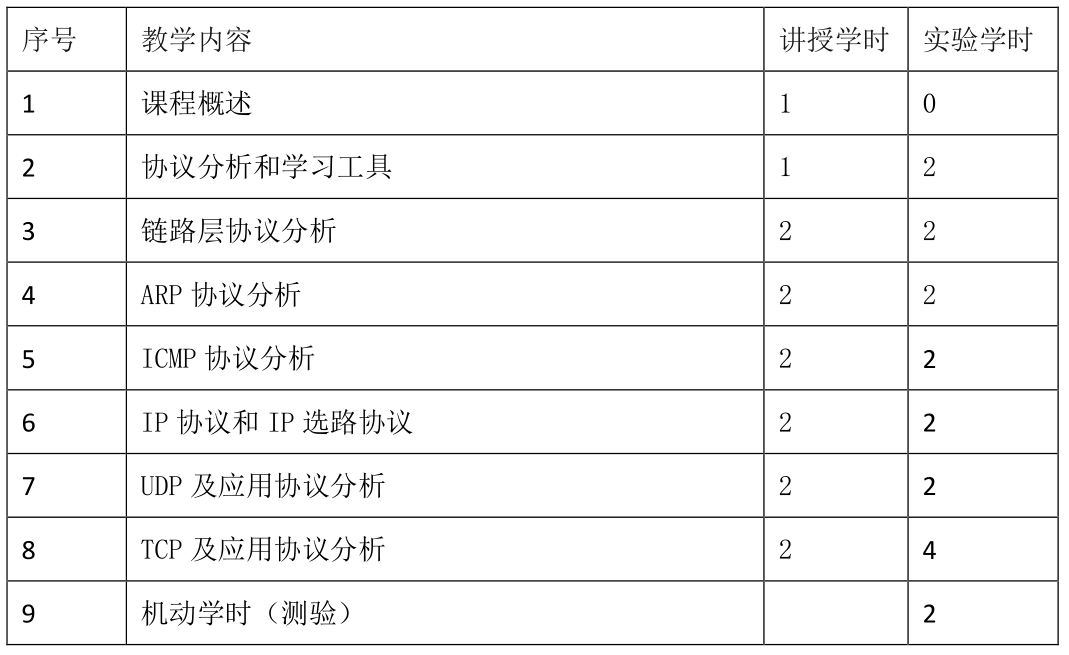
Note: The course teaching is conducted in the laboratory, and the distribution of hours for lectures and practical exercises can be adjusted according to students’ learning situations.
6
Assessment and Grading
Course assessment includes attendance, operational skills, experimental reports, and comprehensive experimental performance.

Note:
(1) Experiments account for 70% of the final score (a total of 7 experimental reports submitted, each worth 10 points);
(2) Students with outstanding performance in experiments or classroom activities may receive extra points (1-5 points added to the total score in the corresponding section).
✦
Supporting Reference Textbooks
✦
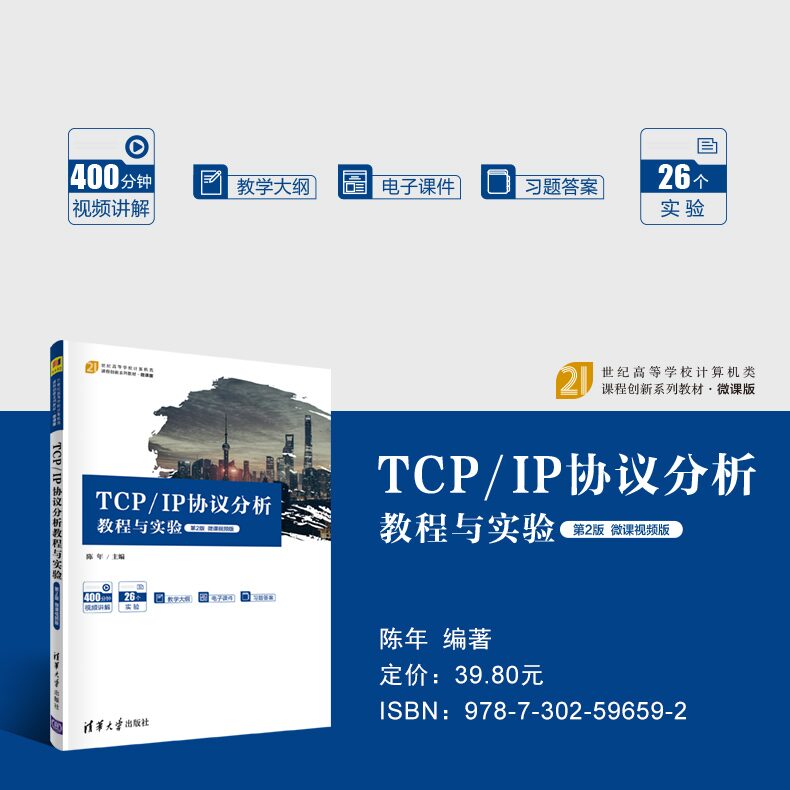
TCP/IP Protocol Analysis Tutorial and Experiment (2nd Edition) Micro-course Video Version
Author: Chen Nian Price: 39.80 RMB ISBN: 9787302596592
Content Introduction
This book introduces the protocols at each layer of the TCP/IP protocol suite using a combination of theory and practice. It selects the main protocols in the TCP/IP protocol framework, including Ethernet and IEEE 802.3, ARP, ICMP, IP, RIP, OSPF, UDP, TCP, DNS, DHCP, SNMP, Telnet, HTTP, and FTP. Based on the introduction of basic principles of protocols, it captures protocol packets in network simulation and real environments for in-depth analysis of protocol working processes. This book visually reproduces the working mechanisms of protocols through experiments, stimulates students’ interest in learning, and enhances students’ engineering practice capabilities. This book can serve as a textbook for undergraduate students studying TCP/IP protocol principles in computer and related majors, as well as a textbook for protocol analysis technology in vocational colleges, and can also serve as a reference book for practitioners in computer networks.
Table of Contents
Swipe up to read
Chapter 1 Overview of TCP/IP Protocol
1.1 Architecture of TCP/IP Protocol
1.1.1 Layering of TCP/IP Protocol
1.1.2 IP Addresses and Ports
1.2 Encapsulation and Demultiplexing
1.2.1 Encapsulation
1.2.2 Demultiplexing
1.3 RFC
1.4 Application Programming Interface
1.4.1 Socket Programming
1.4.2 Libpcap Programming
1.5 Summary
1.6 Exercises
Chapter 2 Protocol Analysis and Learning Tools
2.1 Protocol Analysis
2.1.1 Principles of Protocol Analyzers
2.1.2 Main Uses of Protocol Analyzers
2.2 Cisco Packet Tracer
2.2.1 Working Interface of Packet Tracer
2.2.2 Learning Network Protocol Analysis Using Packet Tracer
2.3 Wireshark
2.3.1 Data Packet Sniffer Wireshark
2.3.2 Working Interface of Wireshark
2.3.3 Basic Operations for Capturing Packets with Wireshark
2.4 GNS3
2.4.1 Installation and Configuration of GNS3
2.4.2 Usage of GNS3
2.5 Sniffer Pro
2.6 Kelai Network Analysis System
2.7 Summary
2.8 Exercises
Experiment
Experiment 2-1 Usage of Packet Tracer 6.0
Experiment 2-2 Usage of Wireshark
Experiment 2-3 Installation and Usage of GNS3
Chapter 3 Link Layer Protocol Analysis
3.1 Role of Link Layer
3.2 Frame Structure of Ethernet
3.2.1 Two Main Standards of Ethernet
3.2.2 Encapsulation Structure of Ethernet Frames
3.3 Link Layer Protocols of Serial Interfaces
3.3.1 SLIP
3.3.2 PPP
3.4 MTU
3.5 Loopback Interfaces
3.6 Summary
3.7 Exercises
Experiment
Experiment 3-1 Analysis of DIX Ethernet V2 Frame Format
Experiment 3-2 Analysis of IEEE 802 Frame Format
Experiment 3-3 Observation of PPP Frames
Experiment 3-4 Loopback Interface
Chapter 4 ARP Protocol Analysis
4.1 Conversion of Physical Addresses and Network Addresses
4.2 Working Principles of ARP Protocol
4.2.1 Example of Address Resolution
4.2.2 Working Process of ARP Protocol
4.2.3 Message Format of ARP Protocol
4.3 Special ARP
4.3.1 Gratuitous ARP
4.3.2 Proxy ARP
4.4 RARP Protocol
4.5 Summary
4.6 Exercises
Experiment
Experiment 4-1 arp Command
Experiment 4-2 ARP Requests and Responses
Experiment 4-3 ARP Proxy
Experiment 4-4 Gratuitous ARP
Chapter 5 ICMP Protocol Analysis
5.1 Role of ICMP
5.2 ICMP Messages and Types
5.2.1 ICMP Message Format
5.2.2 Types of ICMP Messages
5.2.3 ICMP Error Reports
5.2.4 ICMP Control Messages
5.2.5 ICMP Query Messages
5.3 ICMP Testing and Troubleshooting Programs
5.3.1 Ping Program
5.3.2 Traceroute Program
5.4 Summary
5.5 Exercises
Experiment
Experiment 5-1 ICMP Echo Request Messages
Experiment 5-2 Ping Program and IP Options
Experiment 5-3 ICMP Redirect Error Messages
Experiment 5-4 Traceroute Program
Chapter 6 IP Protocol and IP Routing Protocol
6.1 IP Protocol
6.1.1 Transmission Characteristics of IP Layer
6.1.2 Format of IP Datagrams
6.2 IP Routing
6.2.1 Routing Tables and Maintenance
6.2.2 IP Routing Mechanisms
6.3 Dynamic Routing Protocols
6.3.1 RIP Protocol
6.3.2 OSPF Protocol
6.4 IP Fragmentation and Path MTU Discovery
6.4.1 IP Fragmentation
6.4.2 Path MTU Discovery
6.5 Summary
6.6 Exercises
Experiment
Experiment 6-1 route Command and Static Routing
Experiment 6-2 ICMP Host and Network Unreachable Errors
Experiment 6-3 RIP Protocol Analysis
Experiment 6-4 OSPF Protocol Analysis
Experiment 6-5 IP Fragmentation and Path MTU Discovery
Chapter 7 UDP and Application Protocol Analysis
7.1 UDP Protocol
7.1.1 Features of UDP Protocol
7.1.2 Format of UDP Messages
7.2 DNS Protocol
7.2.1 Concepts Related to Domain Name Resolution
7.2.2 Analysis of DNS Message Format
7.2.3 Example of DNS Messages
7.3 DHCP Protocol
7.3.1 Concepts Related to DHCP
7.3.2 Format of DHCP Messages
7.3.3 Example of DHCP Messages
7.4 SNMP Protocol
7.4.1 SNMP Architecture
7.4.2 Management Information Structure
7.4.3 Management Information Base MIB-II
7.4.4 SNMP Security Mechanisms
7.4.5 SNMP Messages
7.4.6 SNMP Operations
7.4.7 Examples of SNMP Messages
7.5 Summary
7.6 Exercises
Experiment
Experiment 7-1 DNS Protocol Analysis
Experiment 7-2 DHCP Protocol Analysis
Experiment 7-3 SNMP Protocol Analysis
Chapter 8 TCP and Application Protocol Analysis
8.1 TCP Protocol
8.1.1 TCP Segment Format
8.1.2 Establishment and Termination of TCP Connections
8.2 Telnet Remote Login
8.2.1 Working Mechanism of Telnet
8.2.2 Examples of Telnet Messages
8.3 HTTP Protocol
8.3.1 Features and Message Formats of HTTP Protocol
8.3.2 Examples of HTTP Messages
8.4 FTP Protocol
8.4.1 Working Principles of FTP Protocol
8.4.2 Examples of FTP Messages
8.5 Summary
8.6 Exercises
Experiment
Experiment 8-1 Analysis of Telnet Program and TCP Connection
Experiment 8-2 HTTP Protocol Analysis
Experiment 8-3 FTP Protocol Analysis
Appendix A Common Cisco Commands
References
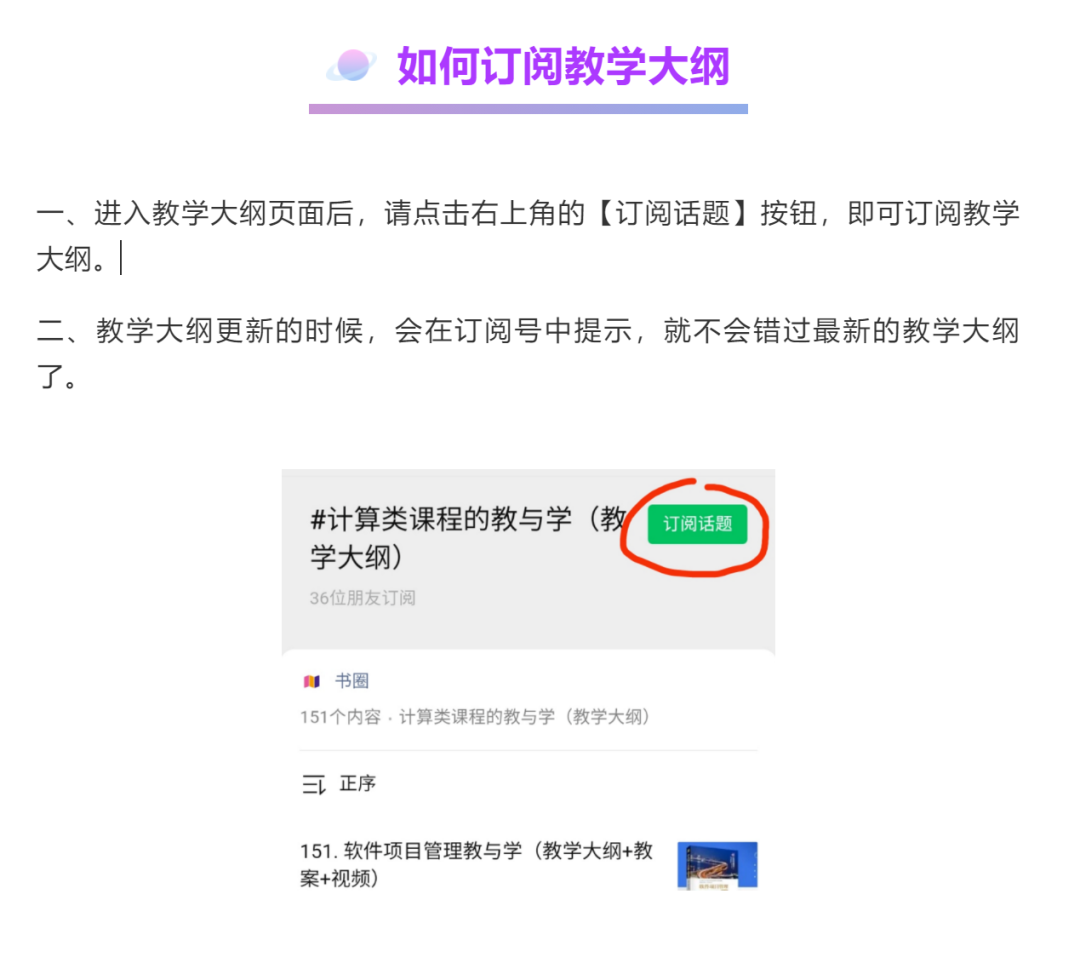
Click the button below 【Read the original text】 to subscribe to the 【Teaching Outline】 column